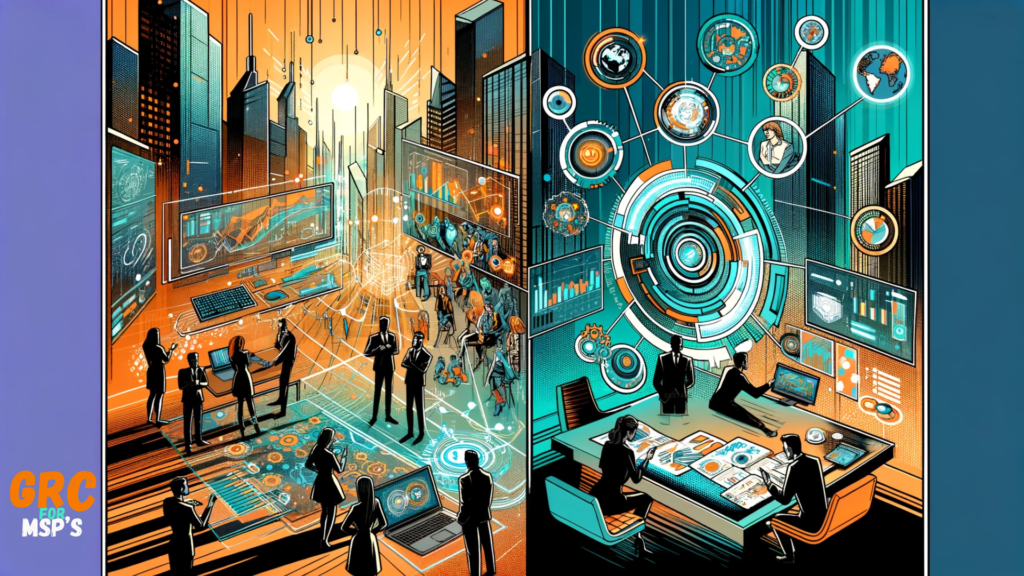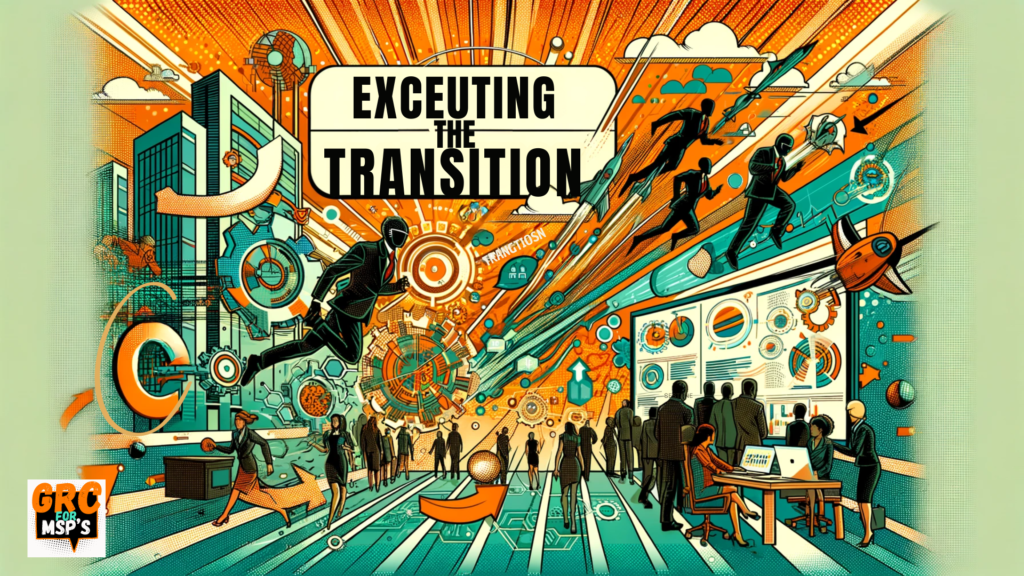
The transition from ISO 27001:2013 to ISO 27001:2022 has become a topic of interest for many Managed Service Providers (MSPs) as the deadline for compliance is approaching. ISO 27001, a globally recognised standard for information security management systems, has been updated to help organisations better address today’s cybersecurity challenges. This update includes significant changes to the structure, processes, and controls involved within the framework.
MSPs must understand the key differences between ISO 27001:2013 and ISO 27001:2022 to ensure a smooth transition. This involves identifying what has remained the same, what has changed, and when the transition needs to occur. Organisations must begin planning and implementing these changes, realigning their information security controls to meet the requirements of the new standard.
Key Takeaways
- ISO 27001:2022 includes several updates addressing modern cybersecurity challenges
- MSPs must evaluate and adapt their information security controls to comply with the updated standard
- The deadline for transitioning from ISO 27001:2013 to ISO 27001:2022 is 31 October 2025
Understanding ISO 27001:2022
Key Changes and Updates
ISO 27001:2022 introduces a restructured and updated set of Annex A controls (Information Security Controls), aligning with ISO/IEC 27002:2022. This revision helps organisations stay up-to-date with the latest cybersecurity practices. It is now more important than ever for Managed Service Providers (MSPs) to obtain ISO 27001:2022 certification to demonstrate robust information security management.
Compliance with ISO 27001:2022 not only strengthens the security of vital data but also helps MSPs meet obligations in regulations such as the Australian Privacy Act 1988, GDPR, and CCPA. These revised controls ensure that an organisation’s Information Security Management System (ISMS) remains effective in tackling emerging threats and risks.
Comparison with ISO 27001:2013
The main differences between ISO 27001:2022 and its 2013 predecessor lie in the structure and content of the Annex A controls. Although the mandatory clauses 4 through 10 have not experienced significant alterations, they have been modified to align with ISO 9001, ISO 14001, and other ISO management standards, as well as with Annex SL.
MSPs transitioning from ISO 27001:2013 to ISO 27001:2022 should familiarise themselves with these changes and updates to ensure a seamless transition to the new standard. Adapting to the ISO 27001:2022 requirements will not only reinforce MSPs’ information security management practices but will also maintain their competitive edge in a demanding market.
Planning for Transition

Initial Assessment and Gap Analysis
Start the transition process from ISO 27001:2013 to ISO 27001:2022 by conducting an initial assessment and gap analysis. This step involves reviewing your current Information Security Management System (ISMS) to identify areas that require updating or improvement to comply with the new standard. Pay specific attention to the updated Annex A controls, which have been reorganised, updated, and extended1.
In addition to changes to ISO 27001, consider other industry-specific standards and regulations such as ISO/IEC 27017 (cloud service providers) and ISO/IEC 27018 (protection of personal data in the cloud) to ensure your MSP is in line with best practices and adheres to relevant data protection rules.
Resource and Timeline Planning
Once you have identified gaps in your ISMS, develop a resource and timeline plan to address these gaps systematically. Implementing the new ISO 27001:2022 standard can take time, so allocate sufficient resources to fully address the required changes. If necessary, engage external consultants for assistance with the transition process. The transition period began in October 2022 and will end in October 20252. Plan the transition audit to ensure completion before the deadline.
Stakeholder Engagement
Involving all relevant stakeholders throughout the transition process is critical to its success. Engaging stakeholders from various departments within your MSP ensures a holistic understanding of the updated ISO 27001 standard, its requirements, and the necessary changes to existing processes and controls. Providing training and continuous education tailored to their role will help them become more familiar with the new standard and contribute to a successful implementation.
Keep in mind that achieving ISO 27001:2022 compliance can offer significant growth opportunities for your MSP. As a result, fostering a culture of information security and complying with ISO standards, including SOC 2 Type II, can enhance your MSP’s credibility and standing in the market.
Footnotes
Executing the Transition

Policy and Control Updates
One of the first steps in transitioning from ISO 27001:2013 to ISO 27001:2022 is updating your policies and controls. The new standard includes a reorganised and extended set of Annex A controls that align with ISO/IEC 27002:2022. It’s important to review these changes and implement them as required. For instance, organisations pursuing compliance with ISO/IEC 20000, SOC 2 + HIPAA, Esquema Nacional de Seguridad (ENS), or Cloud Security Alliance may need to consider specific requirements related to their industry or region.
Training and Awareness Programs
As you update your policies and controls, it’s crucial to make your employees aware of the changes. Creating a culture of compliance requires establishing regular training and awareness programs for your team. Ensure that your training sessions cover all relevant topics, such as MSP-specific risks and requirements, the importance of complying with standards like ISO 27001:2022, and avoiding supply chain attacks.
Monitoring and Continuous Improvement
Finally, to transition successfully and maintain compliance, it’s essential to establish a process for regularly monitoring and improving your information security management system (ISMS). This includes conducting internal audits and using the gathered findings to enhance the effectiveness of your ISMS. By continually reviewing and refining your policies and controls, you can demonstrate your commitment to security, building trust and confidence with clients and stakeholders.
Frequently Asked Questions
What are the primary changes introduced in the ISO 27001:2022 revision?
The major changes in the ISO 27001:2022 revision include updates to Annex A controls, which have been reorganised, updated, and extended, aligning with ISO/IEC 27002:2022. These changes reflect the new technologies, cybersecurity requirements, and industry standards, ensuring the standard remains relevant and effective against evolving threats.
Can you provide a checklist for transitioning from ISO 27001:2013 to ISO 27001:2022?
A detailed checklist is beyond the scope of this brief FAQ section. However, crucial steps for transitioning include:
- Understanding the changes in ISO 27001:2022.
- Updating your Information Security Management System (ISMS) to align with the new version.
- Reviewing all existing annex A controls and implementing the new, updated ones.
- Closing any gaps in your ISMS.
- Reviewing risk assessments and updating them accordingly.
- Training personnel on the new standard and updated processes.
- Conducting internal audits and management reviews.
- Working with a certification body to transition your certification.
How long is the transition period for organisations to comply with ISO 27001:2022?
Organisations have three years from the beginning of the transition period, which started on 31 October 2022, to fully comply with the ISO 27001:2022 standard. By 31 October 2025, businesses must adhere to the revised standard to maintain their certification.
Which steps are crucial for MSPs to start the transition towards ISO 27001:2022?
To begin transitioning, MSPs should first gain a thorough understanding of the changes introduced in ISO 27001:2022. Next, they need to update their ISMS to align with the new version, identify gaps in their current controls, and implement updated controls accordingly. MSPs should also review risk assessments, revise policies and procedures, train employees, and collaborate with a certification body to support the transition.
What are the compliance challenges MSPs might face with the new ISO 27001:2022 standard?
MSPs may face several challenges during the transition, including understanding and implementing updated controls, aligning their ISMS with new technologies, addressing evolving cybersecurity requirements, and adapting to industry standards. Additionally, MSPs may need to invest time and resources into personnel training and updating documentation to ensure compliance. Furthermore, regularly reviewing and continually improving the ISMS is essential to meet the challenges of an evolving threat landscape.
Are there additional controls in ISO 27001:2022, and how do they impact managed service providers?
Yes, ISO 27001:2022 introduces additional controls in Annex A, which affect various aspects, such as organisational structure, risk management, technology integration, and supply chain security. These changes impact MSPs by requiring them to update their ISMS, align with the revised controls, and ensure that their risk assessments and management processes account for the updated set of controls. As a result, MSPs must adapt their cybersecurity strategies and practices to effectively manage the new requirements and maintain their certification.

